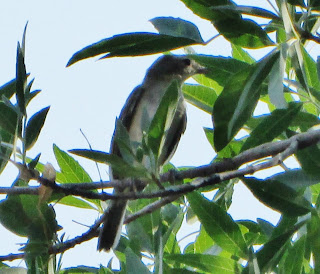 |
| Bell's Vireo |
 |
| Possible Funereal Duskywing |
 |
| Female Broad-billed Hummingbird |
 |
| Male Anna's Hummingbird |
I spent most of the morning photographing lizards in the yard, and with each shot I was expecting to get the "out of memory," signal on the photo card. I was hoping to get some pictures of the Tropical Kingbirds before lunch, so I set out at 10:30 on my quest.
 |
| Cassin's Kingbird |
On the way to the lake I discovered a kingbird, but the contrast between the dark gray head and chest against the white throat proved it to be a Cassin's Kingbird. He was giving his hoarse call sounding like a parent scolding his child to "Come here!" I took some pics, hoping my photo card would hold out.
I remembered my previous blog post and updated my day's quest to see all three kingbirds within this 200 yard section of paradise on this beautiful, 113 degree day.
 |
| Tropical Kingbird |
I only had another twenty minutes for lunch so I hurriedly walked around the lake's shoreline listening for the unmistakable metallic trill of the Tropical Kingbird. Of course when it called the sound came from the furthest point on the far side of the pond. I walked through the heat to the far side, and saw it perched on the low branch of a cottonwood. I decided to snap some shots even though part of its body was blocked. After four pictures my memory did card give out, but one picture still came out nicely (look left). I trudged back, hurrying to lunch and to purchase another memory card.
After a nice long lunch I returned at about 2:00 to the lake to continue my quest. The key to any wildlife quest is to appreciate whatever natural spectacle is before you. This philosophy seems to open up doors to the mysterious natural world, and a seemingly quiet area seems can become a wildlife mecca to those attuned to its melodic frequency. As I walked across the grass this beautiful Monarch Butterfly practically posed for pictures., and I stopped thankfully to fully appreciate its beauty.
 |
| Brown-crested Flycatcher juvenile |
 |
| Brown-crested Flycatcher juvenile |
Separating juvenile Brown-crested and Ash-throated Flycatchers can be difficult. The BC Fly tends to be more yellow on the belly and has a larger bill. The latter field mark, and the call of the nearby, seemingly protective BC Fly is what determined my call on this young bird.

A mysterious splash caught my attention, and I turned to see this image as it disappeared under the surface...
What was it- some sort of manta ray! A mini dragon returning from times past!
When it reappeared it did looked indeed like a son or daughter of Nessie. It slithered forward showing its snake-like neck before disappearing again to the murky depths....
 |
| Neotropic Cormorant |
Later, it finally it came ashore and its pointed yellowish throat helped to solve the mystery of the uncommon, yet always welcome, Neotropic Cormorant. Anyone seeing this bird hold out its outstretched wings to let them dry would think it descended from long lost dragons.
 |
| Vermilion Flycatcher |
I caught sight of another family of Vermilion Flycatchers who nested successfully. The lack of a pinkish vent (shows light yellow here) distinguishes this juvenile from the female adult.
 |
| Tropical Kingbird |
As I watched them light off from the bare branches over the lake I could see they were feeling the heat, actually panting to stay cool. Then one of the birds surprised me by flying down to the water's surface and splashing down temporarily, before returning to his perch. He continued taking "dips," seemingly collecting water on his breast feathers and quenching his thirst simultaneously. The wet breast feathers appeared yellower and a bit shaggier after this performance as shown below.
 |
| Tropical Kingbird |
The excitement of the variety of birds seen made me forget temporarily that I was walking in the open in 113 degree temperatures, without water, and next to a large wash, where heat intensity is greatest. The excitement of nature's variety of life being revealed to me felt like a cool breeze.
I knew my best bet for the third kingbird species would be just a hundred fifty yards across an open, exposed, field toward a large dead Eucalyptus, which currently looked like a blurry impressionist painting from the heat waves distorting its image. It would make one wonder if the tree were just a mirage. I hesitated, looking through the scope to see if any birds could be seen on its bare branches. The clarity was about as clear as an undersea world, but common sense told me nothing would sit exposed in the open on a day like today, except a stupid human looking for birds, I surmised, conclusively as I stepped forward to this new adventure.
I walked with a quick gate toward that magical Eucalyptus which has brought so many amazingly spectacular birds over the years (previous blog entries).
 |
| Western Kingbird |
 |
| Western Kingbird |
 |
| Cooper's Hawk on Nest |
 |
| Abert's Towhee |
On my second round about the shore an Abert's Towhee flew from the cover of the mesquites to the water's edge. The way he stood poised over the cement rim looking toward the water had me convinced he was going to take a dive in his desperation to get some cooling relief.
 |
| Male Purple Martin |
A panting Purple Martin looked on, its dark plumage glistening with the sun's mid afternoon rays.
 |
| Juvenile Ash-throated Flycatcher |
 |
| Mt Lemmon fire as seen from our house (through scope) |


No comments:
Post a Comment